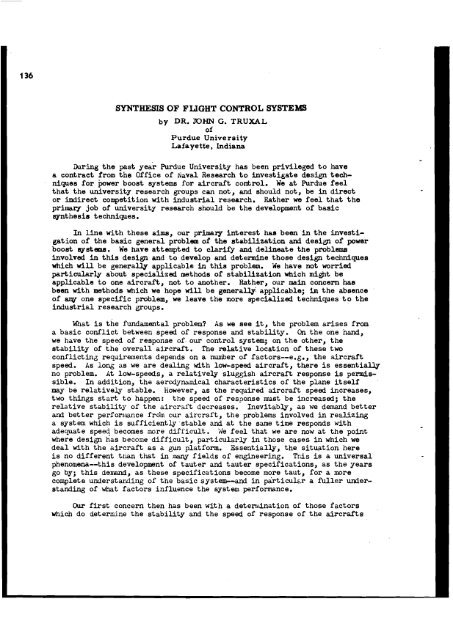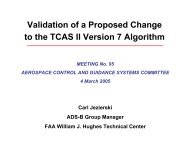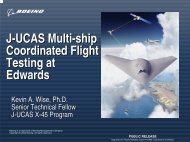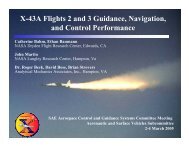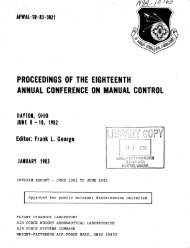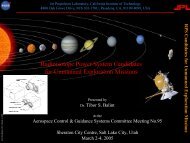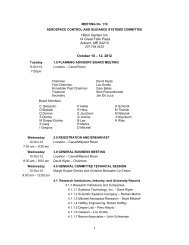Report of the Second Piloted Aircraft Flight Control System - Acgsc.org
Report of the Second Piloted Aircraft Flight Control System - Acgsc.org
Report of the Second Piloted Aircraft Flight Control System - Acgsc.org
Create successful ePaper yourself
Turn your PDF publications into a flip-book with our unique Google optimized e-Paper software.
SYNTHESIS OF FLIGHT CONTROL SYSTEMS<br />
by DR. JOHN G. TRUXAL<br />
<strong>of</strong><br />
Purdue University<br />
Lafayetfe, Indiana<br />
During <strong>the</strong> past year Purdue University has been privileged to have<br />
a contract from <strong>the</strong> Office <strong>of</strong> liaval Research to investigate design techniques<br />
for power boost systems for aircraft control. We at Purdue feel<br />
that <strong>the</strong> university research groups can not, and should not, be in direct<br />
or indirect competition with industrial research. Ra<strong>the</strong>r we feel that <strong>the</strong><br />
primary job <strong>of</strong> university research should be <strong>the</strong> development <strong>of</strong> basic<br />
syn<strong>the</strong>sis techniques.<br />
In line with <strong>the</strong>se aims, our prima~g interest has been in <strong>the</strong> investigation<br />
<strong>of</strong> <strong>the</strong> basic general problem <strong>of</strong> <strong>the</strong> stabilization and design <strong>of</strong> power<br />
boost qystems. He have attempted to clarify and delineate <strong>the</strong> problems<br />
involved in this design and to develop and determine those design technique8<br />
which will be generally applicable in this problem. We have not worried<br />
particularly about specialized methods <strong>of</strong> stabilization which might be<br />
applicable to one aircraft, not to ano<strong>the</strong>r. Ra<strong>the</strong>r, our main concern has<br />
been with methods which we hope will be generally: applicable; in <strong>the</strong> absence<br />
<strong>of</strong> any one specific problem, we leave <strong>the</strong> more specialized techniques to <strong>the</strong><br />
industrial research groups.<br />
What is <strong>the</strong> fundamental problem? As we see it, <strong>the</strong> problem arises from<br />
a basic conflict between speed <strong>of</strong> response and stability. On <strong>the</strong> one nand,<br />
we have <strong>the</strong> speed <strong>of</strong> response <strong>of</strong> our control system; on <strong>the</strong> o<strong>the</strong>r, <strong>the</strong><br />
stability <strong>of</strong> <strong>the</strong> overall aircraft. The relative location <strong>of</strong> <strong>the</strong>se two<br />
conflicting requirements depends on a number <strong>of</strong> factors--e.g., <strong>the</strong> aircraft<br />
speed. As long as we are dealing with low-speed aircraft, <strong>the</strong>re is essentially<br />
no problem. At low-speeds, a relatively sluggish aircraft response is permissible.<br />
In addition, <strong>the</strong> aerodynanlical characteristics <strong>of</strong> <strong>the</strong> plane itself<br />
may be relatively stable. however, as <strong>the</strong> required aircraft speed increases,<br />
two things start to happen: <strong>the</strong> speed <strong>of</strong> response must be increased; <strong>the</strong><br />
relative stability <strong>of</strong> <strong>the</strong> aircraft decreases. Inevitably, as we demand better<br />
and better perforlance frdm our aircraft, <strong>the</strong> problems involved in realizing<br />
a system which is sufficiently stable and at <strong>the</strong> same time responds with<br />
adequate spee4 becomes more difficult . 'tie feel that we are now at <strong>the</strong> point<br />
where design has become difficult, particularu in those cases in which we<br />
deal with <strong>the</strong> aircraft as a gun platform. Essentially, <strong>the</strong> situation here<br />
is no different t t u that in ~nany fields <strong>of</strong> engineering. TPis is a universal<br />
phenoniena--this development <strong>of</strong> tauter and tauter specifications, as <strong>the</strong> years<br />
go by; this demand, as <strong>the</strong>se specifications become more taut, for a more<br />
complete understanding <strong>of</strong> <strong>the</strong> basic system--and in particukr a fuller understanding<br />
<strong>of</strong> what factors influence <strong>the</strong> system performance.<br />
Chw first concern <strong>the</strong>n has been with a deten~unation <strong>of</strong> those factors<br />
which do determine <strong>the</strong> stability and <strong>the</strong> speed <strong>of</strong> response <strong>of</strong> <strong>the</strong> aircrafts


